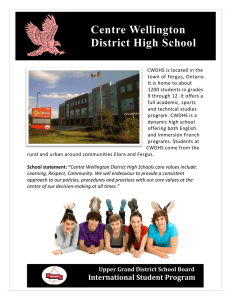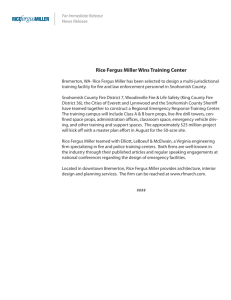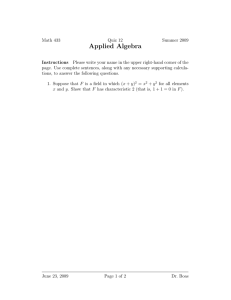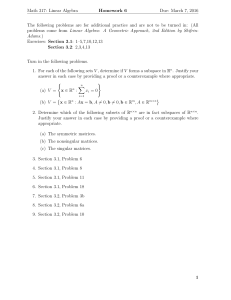The life and work of Fergus Gaines (1939–2001)
advertisement
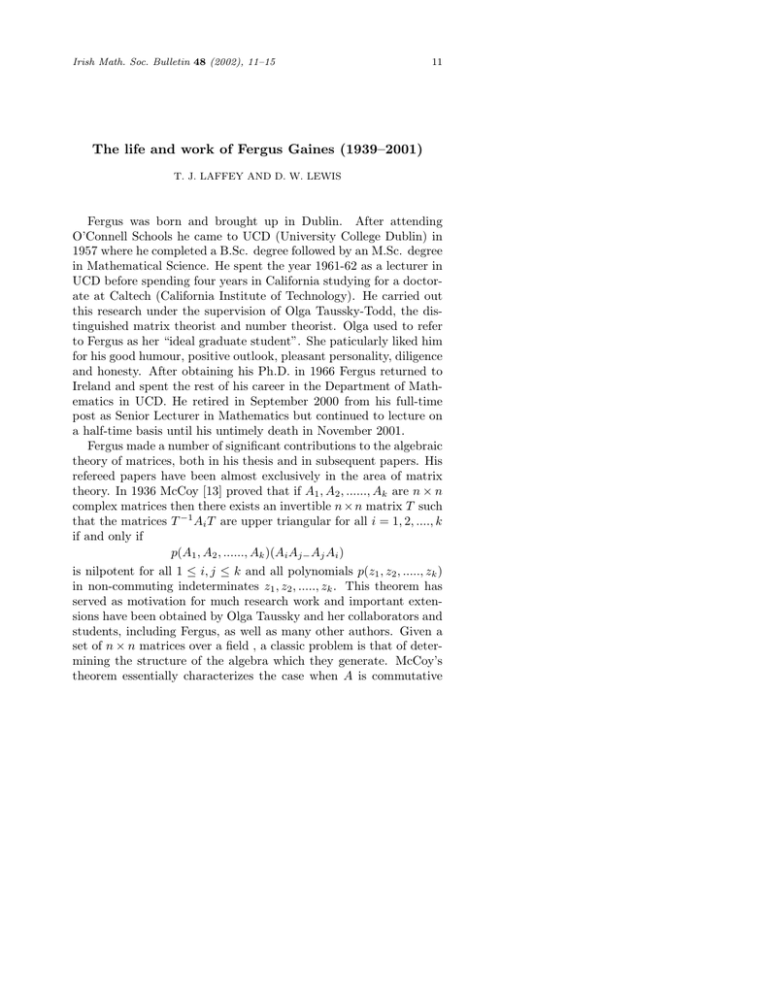
Irish Math. Soc. Bulletin 48 (2002), 11–15 11 The life and work of Fergus Gaines (1939–2001) T. J. LAFFEY AND D. W. LEWIS Fergus was born and brought up in Dublin. After attending O’Connell Schools he came to UCD (University College Dublin) in 1957 where he completed a B.Sc. degree followed by an M.Sc. degree in Mathematical Science. He spent the year 1961-62 as a lecturer in UCD before spending four years in California studying for a doctorate at Caltech (California Institute of Technology). He carried out this research under the supervision of Olga Taussky-Todd, the distinguished matrix theorist and number theorist. Olga used to refer to Fergus as her “ideal graduate student”. She paticularly liked him for his good humour, positive outlook, pleasant personality, diligence and honesty. After obtaining his Ph.D. in 1966 Fergus returned to Ireland and spent the rest of his career in the Department of Mathematics in UCD. He retired in September 2000 from his full-time post as Senior Lecturer in Mathematics but continued to lecture on a half-time basis until his untimely death in November 2001. Fergus made a number of significant contributions to the algebraic theory of matrices, both in his thesis and in subsequent papers. His refereed papers have been almost exclusively in the area of matrix theory. In 1936 McCoy [13] proved that if A1 , A2 , ......, Ak are n × n complex matrices then there exists an invertible n × n matrix T such that the matrices T −1 Ai T are upper triangular for all i = 1, 2, ...., k if and only if p(A1 , A2 , ......, Ak )(Ai Aj− Aj Ai ) is nilpotent for all 1 ≤ i, j ≤ k and all polynomials p(z1 , z2 , ....., zk ) in non-commuting indeterminates z1 , z2 , ....., zk . This theorem has served as motivation for much research work and important extensions have been obtained by Olga Taussky and her collaborators and students, including Fergus, as well as many other authors. Given a set of n × n matrices over a field , a classic problem is that of determining the structure of the algebra which they generate. McCoy’s theorem essentially characterizes the case when A is commutative 12 Obituaries modulo its Jacobson radical. Properties of commutators have been focussed upon because of McCoy’s theorem. Given n × n matrices A, B over a field K, an integer k ≥ 1, and elements x1 , x2 , ........, xN of K where N = k(k − 1)/2, the Kato-Wielandt-Taussky (KTW) commutator fk (A, B, x) := A2N +1 −x1 A2N −1 +x2 A2N −3 −.................+(−1)N A1 , where x = (1, x1 , x2 , ........, xN ), A0 = A, and Ai+1 = Ai B − BAi for each i ≥ 0. Note in particular that f1 (A, B, x) = AB − BA. Taussky, with Kato [14], and with Wielandt [15], proved that if k = n and if xi is the i-th elementary symmetric function in the numbers (β r − β s )2 , 1 ≤ r < s ≤ n, where β 1 , ........, β n are the eigenvalues of B, then fn (A, B, x) = 0. Much of the Ph.D. thesis of Fergus, and two of his papers [3], [4], deal with KTW commutators. In the first paper cited he proves that if K is an infinite field and 1 ≤ k < n, and if A is not a scalar matrix, then there exists a matrix B such that fk (A, B, x) 6= 0 for all x. He also generalizes McCoy’s theorem by relating the sizes of the diagonal blocks in a finest simultaneous block triangularization of a given set S of matrices to commutativity properties of certain KTW commutators, modulo the radical of the algebra generated by S. An unusual result which appears in his paper [3] is as follows: “Every non-scalar matrix over an infinite field is similar to one with none of its entries equal to zero.” While much of the theory of similarity of matrices aims to show that a given matrix is similar to one with relatively few non-zero entries, this result has many applications. For example it follows immediately that if A is not a scalar matrix then there exists a matrix B such that the algebra generated by A, B is the full matrix algebra. Fergus uses this idea very effectively in his paper [6]. Related to simultaneously triangularizable matrices are matrices with the property (L). A pair of n × n matrices A, B over a field K is said to have property (L) if det(xA + yB − zI) is a product of linear factors in the polynomial ring K[x, y, z], where x, y, z are commuting indeterminates. Again many of the deepest results on property (L) are due to Taussky and her collaborators, especially Motzkin. In his paper [4] Fergus makes an interesting contribution to the subject by relating the vanishing of certain KTW commutators to the factorizability of det(xA + yB − zI) into a product of factors of degree Obituaries 13 at most 2. In his paper with R.C.Thompson [11] he discusses the real analogue of McCoy’s theorem and also presents necessary and sufficient commutator-type conditions on a set of matrices in order that they be simultaneously similar to block upper triangular matrices having their diagonal blocks of size at most 2 × 2. This paper has inspired much further work. Laffey [12] has shown that if A, B are complex matrices having quadratic minimal polynomials then they satisfy this conclusion, and Fergus (together with Laffey and H. Shapiro) have obtained best possible bounds on the dimension of the algebra generated by such pairs A, B [10]. In the context of teaching an M.Sc. course on finite projective planes Fergus developed an interest in rings with involution and this led to his very nice characterization of the algebra of quaternions in [5]. The first paper of Fergus in 1966 [1] establishes that every complex matrix of trace zero can be expressed as a commutator XY − Y X where X is hermitian and Y has trace zero. In his second paper [2] he deduces the arithmetic-geometric mean inequality (AGM) from the theorem of Schur which asserts that every complex matrix is unitarily similar to an upper triangular matrix. This was a foretaste of things to come as the (AGM) forms the basis for many International Mathematical Olympiad (IMO) problems and Fergus enjoyed creating and presenting many ingenious problems of this type in recent years. Other topics in which Fergus developed an interest included linear programming, which led to the paper [7], and the numerical range of a matrix, which led to the paper [9]. During his career in UCD Fergus taught an extemely wide range of courses at both undergraduate and postgraduate levels. As well as most of the mainstream courses on analysis and algebra he also taught a few less-standard courses, such as finite projective planes for the M.Sc. programme, mediaeval mathematics for the M.Phil. (Mediaeval Studies) programme, and networks and combinatorial optimization for the Masters in Management Science degree. He contributed greatly to the Monday afternoon algebra seminars which have been operating since the mid-1970s in UCD and he was a main organizer of two international conferences on matrix theory held in UCD in the 1980s [8]. He served terms as President and VicePresident of the Irish Mathematical Society. Fergus became very deeply involved in all aspects of the selection and training of students for the International Mathematical Olympiad, devoting his Saturday mornings to the training sesssions and a lot of his other 14 Obituaries time to inventing and solving Olympiad problems. On a large number of occasions he acted as Leader or Deputy Leader of the Irish IMO team, travelling to many far-flung locations, especially ones on the Asian continent. From the 1960s onwards Fergus maintained a deep interest in Russian language and culture. In the last decade or so he developed a similar passion for Chinese language and culture. Indeed he recently served as President of the Irish-Chinese Cultural Society. On a personal level Fergus befriended a number of Russians who were refugees in Ireland and also a number of Chinese students who had come or aspired to come to Ireland. He was a great source of assistance and support for all of them. Fergus was particularly interested in cultural pursuits, especially music and literature, and had an extensive general knowledge and was an extremely useful addition to any table quiz team. He was a stalwart of the UCD Chess Club. Despite all of his other interests and activities Fergus was a most devoted family man. Friends and colleagues will remember Fergus for his unfailing good nature, energy, enthusiasm, sparkling conversation (unusual for a mathematician!), sense of humour, and positivity of outlook. His death is a tragic loss to his family, his colleagues, and a wide circle of friends in UCD, Ireland, and many other parts of the world. Fergus is survived by his wife Marie, and his five sons and two daughters. References [1] Fergus Gaines, A note on matrices with trace zero, American Mathematical Monthly 73 (1966), 630–631. [2] Fergus Gaines, On the arithmetic mean–geometric mean inequality, American Mathematical Monthly 74 (1967), 305–306. [3] Fergus Gaines, Kato–Wielandt–Taussky commutator relations, Linear Algebra and Appl. 1 (1968), 127–138. [4] Fergus Gaines, Kato–Wielandt–Taussky commutator relations and characteristic curves, Pacific J. Math. 61 (1975), 121–128. [5] F.Gaines, On simple rings with involution, Proc. Royal Irish Acad. Sect. A 76 (1976), 191–193. [6] Fergus Gaines, Some generators for the algebra of n × n matrices, Linear and Multilinear Algebra 5 (1977/8), 95–98. [7] Fergus Gaines, Recent developments in linear programming, Irish Math. Soc. Newsletter 7 (1984), 29–35. [8] F.J.Gaines and T.J.Laffey, Report on Dublin Matrix Theory Conference, March 1984, Linear Algebra and Appl. 68 (1985), 127–135. Obituaries 15 [9] F.J.Gaines and T.J.Laffey, Permutation matrices with normal sum, Proc. Royal Irish Acad. Sect. A 75 (1975), 227 – 254. [10] Fergus J. Gaines, Thomas J. Laffey and Helene M. Shapiro, Pairs of matrices with quadratic minimal polynomial, Linear Algebra and Appl. 52/53 (1983), 289 – 292. [11] Fergus J. Gaines and R.C.Thompson, Sets of nearly triangular matrices, Duke Math. J. 35 (1968), 441 –453. [12] Thomas J. Laffey, Algebras generated by two idempotents, Linear Algebra and Appl. 37 (1981), 45–53. [13] Neal H.McCoy, On the characteristic roots of matric polynomials, Bull. Amer. Math. Soc. 42 (1936), 592–600. [14] T.Kato and O.Taussky, Commutators of A and A∗ , J.Washington Acad. Sc. 46 (1956), 38–40. [15] O.Taussky and H.Wielandt, Linear relations between higher additive commutators, Proc. Amer. Math. Soc. 13 (1962), 732–735. T. J. Laffey, D. W. Lewis, Department of Mathematics, University College Dublin, Dublin, Ireland thomas.laffey@ucd.ie, david.lewis@ucd.ie
